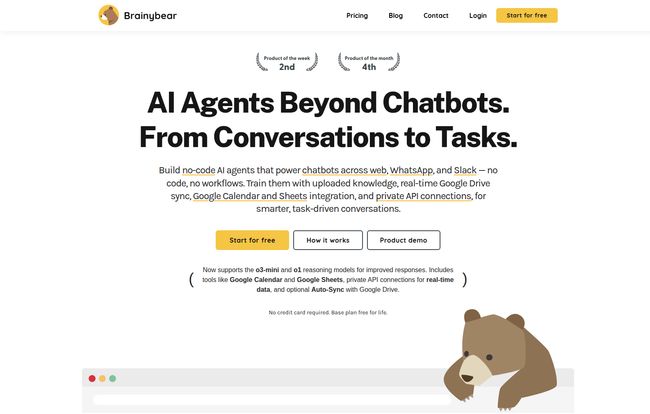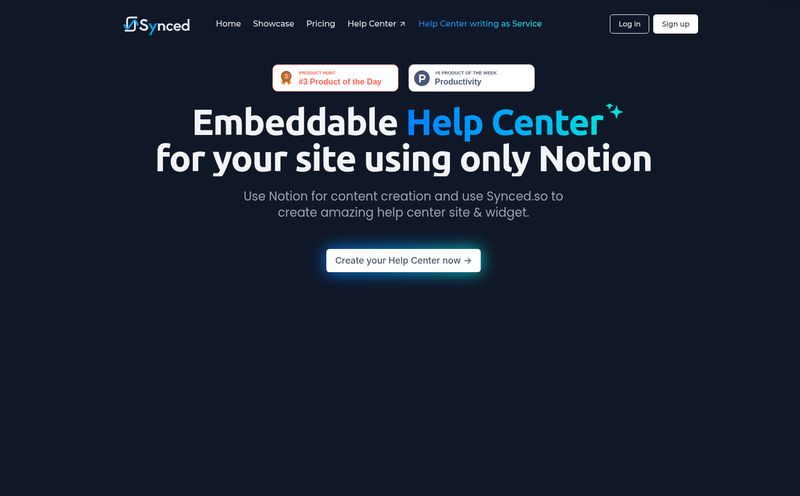I’ve been in the SEO and traffic generation world for what feels like an eternity. Long enough to remember when adding a chatbot to a website was the peak of innovation. And long enough to know most of them are… well, a bit rubbish. You know the drill. You ask a simple question, and it responds with a pre-programmed answer that’s only vaguely related, forcing you to click through a maze of buttons. It’s like talking to a vending machine that only dispenses frustration.
For years, we've been stuck with these rigid, flow-based bots. They’re glorified FAQ pages with a chat window. But the ground is shifting. We're moving from basic chatbots to true AI agents—tools that can think, learn, and actually perform tasks. And that’s where platforms like Brainybear are starting to make some serious noise. I decided to get my hands dirty and see if it lives up to the hype.
So, What is Brainybear, Really?
Let's get one thing straight: calling Brainybear just another chatbot builder is like calling a smartphone just a phone. It misses the whole point. Brainybear is an AI agent platform. The difference is subtle but massive. A traditional chatbot follows a script. It’s a flowchart. If a user says X, you respond with Y. Boring, rigid, and breaks the second a user goes off-script.
An AI agent, on the other hand, is like hiring a new intern who’s a ridiculously fast learner. You don't give it a script; you give it a knowledge base. You say, “Here’s our entire product catalog, our Google Drive folder with support docs, and access to our shipping API. Now, go help customers.” It reads, understands context, and can even perform actions based on the information it has. It’s a conversation that leads to a conclusion, not just a dead end.

Visit Brainybear
The Real Difference: AI Agents vs. Old-School Chatbots
The homepage for Brainybear lays this out pretty clearly, and honestly, it’s refreshing. They pit the old “Flow-Based Chatbots” against their “Brainybear AI Agents.” And it’s not just marketing fluff. I've spent too many hours in clunky drag-and-drop editors, trying to predict every single thing a customer might say. It’s a nightmare.
The old way is reactive. Limited to pre-defined paths. No real learning. It’s static. Brainybear’s approach is dynamic. It’s designed to handle queries you haven’t even thought of yet because it understands the intent behind the words, not just the words themselves. It’s context-aware, learns from every conversation, and can even access real-time data. This is the stuff we were promised years ago!
The Features That Actually Matter
Okay, features lists can be boring, but a few things on Brainybear's list genuinely caught my eye as someone who has to implement these tools for clients.
Training Your AI on Your Company’s Brain
This is the big one. The quality of an AI is directly tied to the quality of its data. Brainybear lets you train your agent by uploading files (like PDFs and docs), connecting directly to a Google Drive folder for a real-time sync, or even connecting to private APIs. That Google Drive sync is a game-changer. It means your support team can update a Google Doc, and the AI agent instantly knows the new information. No redeploying, no re-training, no developer needed. That’s huge.
A Multi-Platform Personality
Your customers aren't just on your website. They’re on WhatsApp, Slack, and Facebook Messenger. Brainybear integrates directly with these platforms, so you can build one agent and deploy it everywhere your audience lives. And with support for over 80 languages, it’s not just for English-speaking markets. I haven’t tested all 80, mind you, but the promise is there.
It Genuinely Gets Smarter
This isn't a 'set it and forget it' tool that gathers dust. The platform boasts that the AI learns and improves with every single interaction. It sees what questions are being asked, how it’s responding, and (I assume) gets feedback to refine its future answers. This continuous learning loop is what separates a gimmick from a core business tool.
Let's Talk Money: The Brainybear Pricing Breakdown
Alright, let's get to the brass tacks. Is it going to cost you an arm and a leg? Well, it depends on your scale. The pricing model is based on tiers and a credit system, which is pretty common in the AI space. Think of it like an arcade—different games (or AI models) cost a different number of tokens (or credits).
Here’s a simplified breakdown of their plans:
| Plan | Price | Best For |
|---|---|---|
| Free | $0 /mo | Kicking the tires and seeing the magic. You get 50 message credits to explore. |
| Basic | $38 /mo | Small businesses or solopreneurs who need a solid customer-facing AI. |
| Growth | $89 /mo | The sweet spot. More credits, better AI models (like GPT-4o), and WhatsApp integration. |
| Business | $189 /mo | High-volume sites that need serious power, custom teams, and smart scheduling. |
The credit system is important to understand. A simple query using the GPT-3.5-mini model might only cost 1 credit per message. But a more complex conversation using the powerful GPT-4 Turbo model will cost 20 credits per message. It’s a fair way to price based on resource use, but you'll need to monitor your consumption, especially if you get a sudden traffic spike from a successful campaign.
The Good and The Not-So-Good
Okay, no tool is perfect. After playing around and digging through the details, here’s my honest take.
"One great feature is the seamless integration with Facebook Messenger and WhatsApp. It's a bliss!" - Stephen Scott (from Brainybear's site)
I have to agree with Stephen here. The setup is remarkably straightforward for a tool this powerful. You’re not wrestling with complex workflows. The conversational quality is top-notch, and the ability to train it on your own private data without being a data scientist is its killer feature.
However, nothing's without its quirks. The message credit system, while fair, means you need to be mindful of your budget. A viral blog post could burn through your monthly credits faster than you expect. Also, some of the really powerful features, like API connections and removing the Brainybear branding, are locked behind the higher-priced plans. And at teh end of the day, it's still reliant on the underlying AI models from providers like OpenAI, which means it can occasionally hallucinate or give a slightly weird answer. It's a hazard of the entire AI industry right now, not just a Brainybear thing.
So, Who is This Really For?
I see a few groups getting a ton of value from Brainybear:
- eCommerce Store Owners: Imagine an agent that can answer product questions, check stock levels via API, and handle returns questions 24/7. That's a huge time-saver.
- SaaS Companies: Perfect for building an intelligent onboarding bot or a first-line-of-defense support agent that can answer common questions before escalating to a human.
- Marketing Agencies: A fantastic tool to offer clients who want to improve lead generation and customer engagement without a massive overhead.
If you're a massive global enterprise with incredibly strict, bespoke compliance needs, you might still need a fully custom-coded solution. But for the other 98% of businesses, Brainybear seems to hit a real sweet spot between power, usability, and price.
Frequently Asked Questions
- What’s the real difference between a chatbot and a Brainybear AI agent?
- Think of it this way: a chatbot reads a script. An AI agent reads a library. The agent can understand context, handle unexpected questions, and even perform tasks, while a chatbot is stuck on its pre-programmed path.
- How hard is it to connect Brainybear to WhatsApp?
- Based on their documentation and user reviews, it’s designed to be straightforward. You'll need the Growth plan or higher, but it doesn't require deep technical knowledge. It's more about following a setup process than writing code.
- Is the free plan actually useful?
- Yes, absolutely. 50 credits isn't enough to run your business on, but it's more than enough to build a test agent, train it on a few documents, and see for yourself how it works. It's a proper trial, not a crippled version.
- How does the AI credit system work?
- You buy a number of credits with your monthly plan. Each message sent by the AI uses a certain number of credits. Simpler AI models (like GPT-3.5-mini) use fewer credits, while more powerful models (like GPT-4 Turbo) use more. This lets you balance performance with cost.
- Is my data safe with Brainybear?
- They take security seriously. The website mentions they've passed the Cloud Application Security Assessment (CASA), which is based on the OWASP Application Security Verification Standard (ASVS). That’s a good sign that they're committed to enhanced user data protection.
My Final Verdict: Is Brainybear Worth Your Time?
In a word, yes. For me, Brainybear represents a significant jump from the last generation of customer interaction tools. We’re finally moving past the clunky, frustrating bots of yesteryear and into an era of genuinely helpful AI assistants. The ease of training, the multi-platform support, and the fair pricing tiers make it an incredibly compelling option for almost any business looking to automate smartly.
It’s not magic—you still need to provide good data for it to learn from—but it’s the closest thing I’ve seen to a plug-and-play AI workforce. If you've been on the fence about AI for your business, I’d say their free plan is a no-brainer. Go build something, and see what the future of customer conversation feels like.



